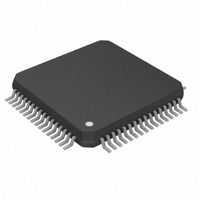DS26521L+ Maxim Integrated Products, DS26521L+ Datasheet - Page 9

DS26521L+
Manufacturer Part Number
DS26521L+
Description
IC TXRX T1/E1/J1 64-LQFP
Manufacturer
Maxim Integrated Products
Type
Line Interface Units (LIUs)r
Datasheet
1.DS26521LN.pdf
(258 pages)
Specifications of DS26521L+
Number Of Drivers/receivers
1/1
Protocol
T1/E1/J1
Voltage - Supply
3.135 V ~ 3.465 V
Mounting Type
Surface Mount
Package / Case
64-LQFP
Product
Framer
Number Of Transceivers
1
Data Rate
44.736 Mbps
Supply Voltage (max)
3.465 V
Supply Voltage (min)
3.135 V
Supply Current (max)
220 mA
Maximum Operating Temperature
+ 85 C
Minimum Operating Temperature
- 40 C
Mounting Style
SMD/SMT
Lead Free Status / RoHS Status
Lead free / RoHS Compliant
- Current page: 9 of 258
- Download datasheet (2Mb)
1.
The DS26521 is a single-channel device that can be software configured for T1, E1, or J1 operation. The DS26521
is composed of a line interface unit (LIU), framer, HDLC controller, and a TDM backplane interface, and is
controlled by either an 8-bit parallel port or a serial peripheral interface (SPI). Internal impedance matching is
provided for both transmit and receive paths reducing external component count. The DS26521 is a member of the
TEX-series transceiver family and is software compatible with the DS26522 dual, DS26524 quad, and DS26528
octal transceivers.
The LIU is composed of a transmit interface, receive interface, and a jitter attenuator. The transmit interface is
responsible for generating the necessary waveshapes for driving the network and providing the correct source
impedance depending on the type of media used. T1 waveform generation includes DSX-1 line build-outs as well
as CSU line build-outs of 0dB, -7.5dB, -15dB, and -22.5dB. E1 waveform generation includes G.703 waveshapes
for both 75Ω coax and 120Ω twisted cables. The receive interface provides network termination and recovers clock
and data from the network. The receive sensitivity adjusts automatically to the incoming signal level and can be
programmed for 0dB to -43dB or 0dB to -12dB for E1 applications and 0dB to -15dB or 0dB to -36dB for T1
applications. The jitter attenuator removes phase jitter from the transmitted or received signal. The crystal-less jitter
attenuator requires only a T1 or E1 clock rate, or multiple thereof, for both E1 and T1 applications, and can be
placed in either transmit or receive data paths.
On the transmit side, clock, data, and frame-sync signals are provided to the framer by the backplane interface
section. The framer inserts the appropriate synchronization framing patterns, alarm information, calculates and
inserts the CRC codes, and provides the B8ZS/HDB3 (zero code suppression) and AMI line coding. The receive-
side framer decodes AMI, B8ZS, and HDB3 line coding, synchronizes to the data stream, reports alarm
information, counts framing/coding/CRC errors, and provides clock, data, and frame-sync signals to the backplane
interface section.
Both transmit and receive paths have access to an HDLC controller. The HDLC controller transmits and receives
data via the framer block. The HDLC controller can be assigned to any time slot, a portion of a time slot, or to FDL
(T1) or Sa bits (E1). Each controller has 64-byte FIFOs, reducing the amount of processor overhead required to
manage the flow of data.
The backplane interface provides a versatile method of sending and receiving data from the host system. Elastic
stores provide a method for interfacing to a system backplane, converting from a T1/E1 network to a 2.048MHz,
4.096MHz, 8.192MHz, 16.384MHz, or N x 64kHz system backplane. The elastic stores also manage slip conditions
(asynchronous interface). The interleave bus option (IBO) is provided to allow up to eight transceivers to share a
high-speed backplane. The DS26521 also contains an internal clock adapter useful for the creation of a
synchronous, high-frequency backplane timing source.
The parallel port and SPI port provide access for configuration and status of all the DS26521’s features. Diagnostic
capabilities include loopbacks, PRBS pattern generation/detection, and 16-bit loop-up and loop-down code
generation and detection.
1.1
The DS26521 has two major modes of operation: T1 mode and E1 mode. The mode of operation for the LIU is
configured in the LIU Transmit Receive Control register (LTRCR). The mode of operation for the framer is
configured in the Transmit Master Mode register (TMMR) and Receive Master Mode register (RMMR). J1 operation
is a special case of T1 operating mode.
DETAILED DESCRIPTION
Major Operating Modes
9 of 258
DS26521 Single T1/E1/J1 Transceiver
Related parts for DS26521L+
Image
Part Number
Description
Manufacturer
Datasheet
Request
R

Part Number:
Description:
MAX7528KCWPMaxim Integrated Products [CMOS Dual 8-Bit Buffered Multiplying DACs]
Manufacturer:
Maxim Integrated Products
Datasheet:

Part Number:
Description:
Single +5V, fully integrated, 1.25Gbps laser diode driver.
Manufacturer:
Maxim Integrated Products
Datasheet:

Part Number:
Description:
Single +5V, fully integrated, 155Mbps laser diode driver.
Manufacturer:
Maxim Integrated Products
Datasheet:

Part Number:
Description:
VRD11/VRD10, K8 Rev F 2/3/4-Phase PWM Controllers with Integrated Dual MOSFET Drivers
Manufacturer:
Maxim Integrated Products
Datasheet:

Part Number:
Description:
Highly Integrated Level 2 SMBus Battery Chargers
Manufacturer:
Maxim Integrated Products
Datasheet:

Part Number:
Description:
Current Monitor and Accumulator with Integrated Sense Resistor; ; Temperature Range: -40°C to +85°C
Manufacturer:
Maxim Integrated Products

Part Number:
Description:
TSSOP 14/A°/RS-485 Transceivers with Integrated 100O/120O Termination Resis
Manufacturer:
Maxim Integrated Products

Part Number:
Description:
TSSOP 14/A°/RS-485 Transceivers with Integrated 100O/120O Termination Resis
Manufacturer:
Maxim Integrated Products

Part Number:
Description:
QFN 16/A°/AC-DC and DC-DC Peak-Current-Mode Converters with Integrated Step
Manufacturer:
Maxim Integrated Products

Part Number:
Description:
TDFN/A/65V, 1A, 600KHZ, SYNCHRONOUS STEP-DOWN REGULATOR WITH INTEGRATED SWI
Manufacturer:
Maxim Integrated Products

Part Number:
Description:
Integrated Temperature Controller f
Manufacturer:
Maxim Integrated Products

Part Number:
Description:
SOT23-6/I°/45MHz to 650MHz, Integrated IF VCOs with Differential Output
Manufacturer:
Maxim Integrated Products

Part Number:
Description:
SOT23-6/I°/45MHz to 650MHz, Integrated IF VCOs with Differential Output
Manufacturer:
Maxim Integrated Products

Part Number:
Description:
EVALUATION KIT/2.4GHZ TO 2.5GHZ 802.11G/B RF TRANSCEIVER WITH INTEGRATED PA
Manufacturer:
Maxim Integrated Products

Part Number:
Description:
QFN/E/DUAL PCIE/SATA HIGH SPEED SWITCH WITH INTEGRATED BIAS RESISTOR
Manufacturer:
Maxim Integrated Products
Datasheet:










